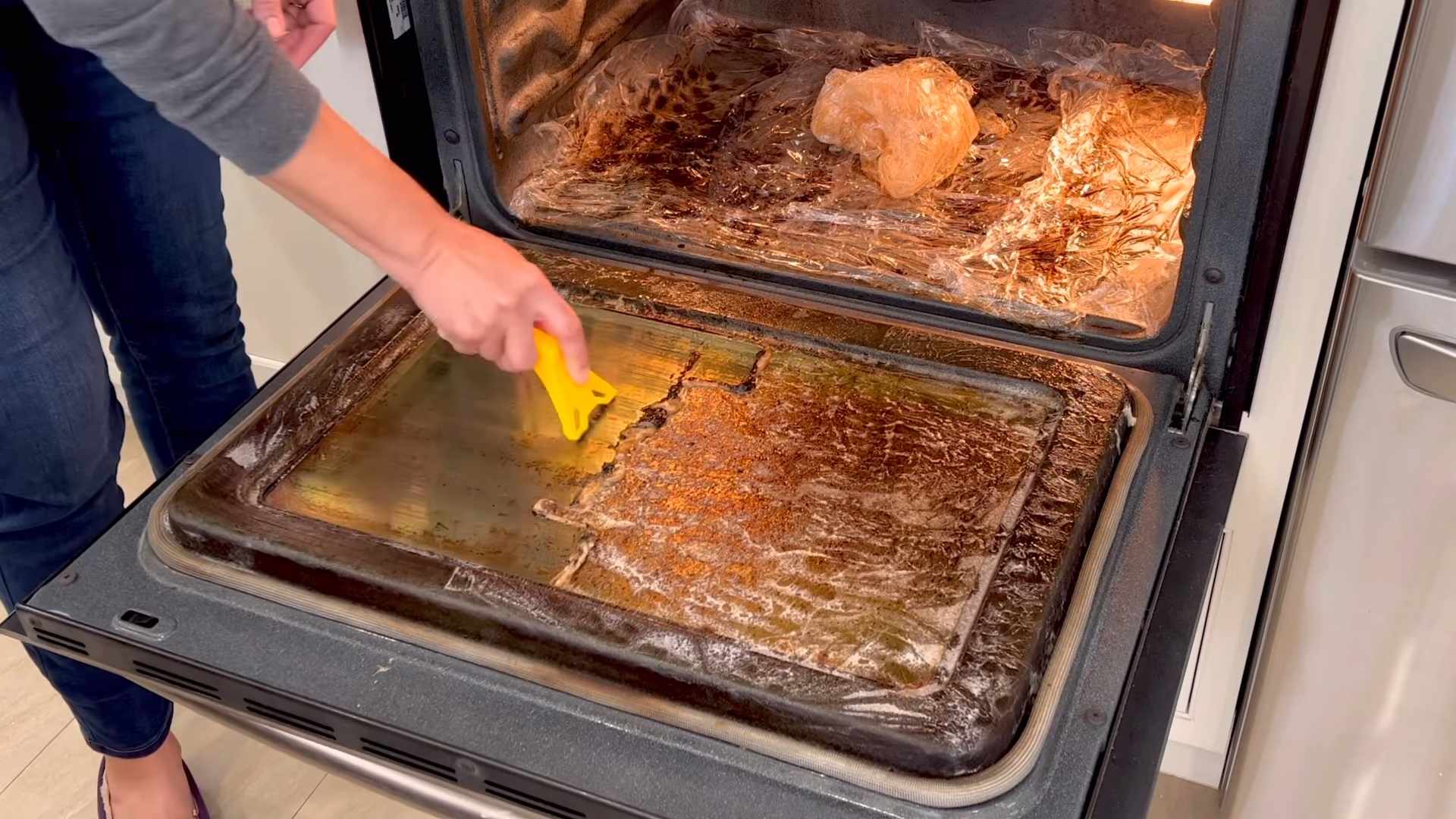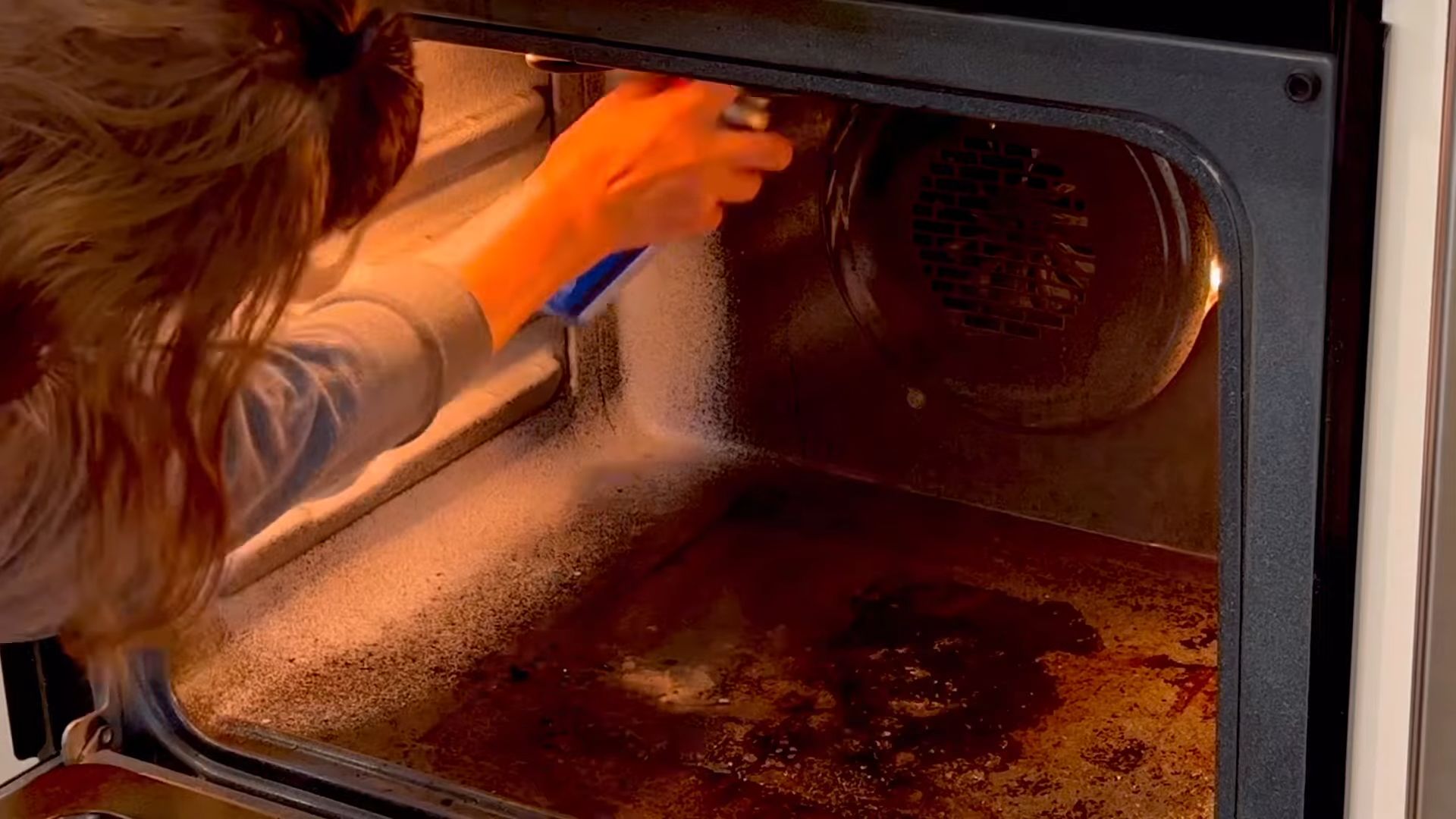Clean Your Oven Easily? Sounds too good to be true, right? I know, I know, the thought of tackling that greasy, burnt-on mess inside your oven probably fills you with dread. But what if I told you there’s a way to make oven cleaning not just bearable, but actually… easy? We’re diving into a simple, effective DIY trick that will leave your oven sparkling without harsh chemicals or hours of scrubbing!
For generations, keeping a clean oven was a back-breaking chore. Our grandmothers relied on elbow grease and strong lye-based cleaners – a far cry from the gentler, more eco-friendly methods we can use today. This DIY hack builds upon that spirit of resourcefulness, using common household ingredients to achieve professional-level results.
Let’s face it, a dirty oven impacts more than just your kitchen’s aesthetics. Burnt food residue can affect the taste of your dishes, and a grimy oven is less efficient, costing you more in energy bills. Plus, who wants to peek through a blackened oven door to check on their baking masterpiece? That’s why learning how to clean your oven easily is a game-changer. It’s not just about cleanliness; it’s about better food, energy savings, and a happier cooking experience. So, grab your supplies, and let’s get started!

DIY Oven Cleaning Hack: Sparkling Clean Without the Harsh Chemicals!
Okay, let’s be honest, cleaning the oven is probably on everyone’s list of least favorite chores. The baked-on grime, the lingering smells, the sheer effort… it’s enough to make anyone want to order takeout every night! But fear not, my friends! I’m going to share my super-easy, super-effective, and totally natural oven cleaning hack that will leave your oven sparkling without any harsh chemicals or elbow grease. Trust me, you’ll thank me later!
What You’ll Need: The Arsenal of Clean
Before we dive in, let’s gather our supplies. This is a pretty simple recipe, so you probably already have most of these things on hand.
* Baking Soda: The star of the show! Baking soda is a natural deodorizer and mild abrasive, perfect for loosening baked-on messes.
* White Vinegar: The dynamic duo! Vinegar reacts with baking soda to create a fizzing action that helps lift grime.
* Water: For mixing and rinsing.
* Spray Bottle: To apply the vinegar solution.
* Spatula or Scraper: For removing stubborn gunk.
* Sponge or Cloth: For wiping and scrubbing.
* Rubber Gloves: To protect your hands. (Optional, but recommended!)
* Old Towels or Rags: For soaking up spills and messes.
* Small Bowl: For mixing the baking soda paste.
Phase 1: The Baking Soda Paste Application
This is where the magic begins! We’re going to create a baking soda paste that will sit in your oven overnight, working its magic to loosen all that baked-on gunk.
1. Empty the Oven: First things first, remove everything from your oven – racks, baking stones, thermometers, anything that’s not permanently attached. We want a clean slate to work with.
2. Mix the Baking Soda Paste: In your small bowl, combine about ½ cup of baking soda with enough water to form a thick, spreadable paste. You want it to be the consistency of frosting. Add water gradually, mixing as you go, until you reach the right consistency.
3. Coat the Oven: Now, put on your gloves (if you’re using them) and spread the baking soda paste all over the interior surfaces of your oven. This includes the walls, the floor, the door (inside), and even the ceiling. Avoid the heating elements! You want a nice, even layer. Don’t be shy – really get in there and cover everything.
4. Tackle Stubborn Spots: For particularly stubborn spots, like baked-on spills or grease splatters, apply a thicker layer of the paste. Really pack it on there!
5. Leave it Overnight: This is the key! Let the baking soda paste sit in your oven for at least 12 hours, or even better, overnight. The longer it sits, the more effective it will be at loosening the grime. I usually do this before bed so it has all night to work its magic.
Phase 2: The Vinegar Activation and Scrubbing
The next day, it’s time to unleash the power of vinegar! This is where the fizzing action comes in, helping to lift the loosened grime and make it easier to wipe away.
1. Prepare the Vinegar Solution: Fill your spray bottle with plain white vinegar. No need to dilute it!
2. Spray the Vinegar: Generously spray the baking soda paste with vinegar. You’ll see it start to fizz and bubble – that’s exactly what we want! The vinegar is reacting with the baking soda, creating a natural cleaning action.
3. Let it Fizz: Allow the vinegar to fizz for a few minutes. This will help to further loosen the grime.
4. Scrub-a-dub-dub: Now, grab your sponge or cloth and start scrubbing! You’ll be amazed at how easily the grime comes off. The baking soda paste has already done most of the work, so you shouldn’t have to scrub too hard.
5. Use the Spatula: For any stubborn spots that are still clinging on, use your spatula or scraper to gently scrape them away. Be careful not to scratch the oven surface!
6. Wipe Away the Residue: As you scrub, wipe away the loosened grime and baking soda residue with a clean, damp cloth. Rinse the cloth frequently to avoid spreading the grime around.
Phase 3: Rinsing and Drying
Almost there! Now we just need to rinse away any remaining residue and dry the oven.
1. Rinse Thoroughly: Use a clean, damp cloth to rinse the entire interior of the oven. You may need to rinse several times to remove all traces of baking soda and vinegar. Make sure you get into all the corners and crevices.
2. Dry the Oven: Once you’ve rinsed the oven thoroughly, use a clean, dry towel to dry the interior. This will prevent any water spots from forming.
3. Clean the Racks: While you’re at it, don’t forget to clean the oven racks! You can soak them in a sink full of hot, soapy water, or you can use the same baking soda paste and vinegar method to clean them. I often find that soaking them in the bathtub works best for larger racks.
4. Reassemble: Once everything is clean and dry, put the oven racks and any other items you removed back into the oven.
Tips and Tricks for Oven Cleaning Success
* Don’t Forget the Door: Pay special attention to the oven door, as this is often where the most grime accumulates. Make sure to clean both the inside and outside of the door.
* Clean the Glass: To clean the glass on the oven door, you can use the same baking soda paste and vinegar method. Just be careful not to scratch the glass. Alternatively, you can use a commercial glass cleaner.
* Ventilation is Key: Make sure to ventilate your kitchen while you’re cleaning the oven. Open a window or turn on the exhaust fan to help dissipate any odors.
* Preventative Measures: To prevent your oven from getting too dirty in the first place, try to wipe up spills as soon as they happen. You can also use oven liners to catch drips and splatters.
* Regular Cleaning: Cleaning your oven regularly will make the job much easier in the long run. Try to clean it at least once a month, or more often if you use it frequently.
* For Self-Cleaning Ovens: Even if you have a self-cleaning oven, this method can be helpful for removing stubborn spots or for cleaning the oven door. Just be sure to consult your oven’s manual before using any cleaning products.
* Dealing with Burnt Sugar: Burnt sugar can be particularly difficult to remove. For these spots, try soaking them with a damp cloth for a few minutes before scrubbing. You can also try using a paste of baking soda and hydrogen peroxide.
* Vinegar Smell: If you’re sensitive to the smell of vinegar, you can add a few drops of essential oil to the vinegar solution. Lavender, lemon, or orange essential oils work well.
* Test in an Inconspicuous Area: Before applying the baking soda paste to the entire oven, test it in an inconspicuous area to make sure it doesn’t damage the surface.
* Safety First: Always wear gloves when cleaning the oven to protect your hands from harsh chemicals and grime. And be sure to unplug the oven before you start cleaning!
Troubleshooting Common Oven Cleaning Problems
* Baking Soda Paste is Too Dry: If your baking soda paste is too dry, add a little more water until it reaches the desired consistency.
* Baking Soda Paste is Too Runny: If your baking soda paste is too runny, add a little more baking soda until it thickens up.
* Grime is Still Stubborn: If the grime is still stubborn after scrubbing, try applying a fresh layer of baking soda paste and letting it sit for a few more hours. You can also try using a stronger abrasive, such as a scouring pad.
* Vinegar is Not Fizzing: If the vinegar is not fizzing, make sure you’re using plain white vinegar and that the baking soda paste is still damp.
* Oven Still Smells: If your oven still smells after cleaning, try placing a bowl of baking soda in the oven overnight to absorb any lingering odors. You can also try heating a lemon cut in half in the oven for an hour at 200 degrees Fahrenheit.
With a little bit of baking soda, vinegar, and elbow grease (okay, maybe not too much elbow grease!), you can have a sparkling clean oven without resorting to harsh chemicals. This method is not only effective but also safe for your family and the environment. So, go ahead and give it a try – you’ll be amazed at the results! Happy cleaning!

Conclusion
So, there you have it! Cleaning your oven doesn’t have to be a dreaded chore involving harsh chemicals and hours of scrubbing. This simple, effective, and surprisingly satisfying DIY trick using readily available ingredients will revolutionize your oven cleaning routine. We’ve shown you how to harness the power of baking soda and vinegar – a dynamic duo that tackles baked-on grease and grime without the fumes or the expense of commercial oven cleaners.
Why is this a must-try? Because it’s safe for your family, safe for the environment, and incredibly effective. You’ll be amazed at how easily the grime lifts away after the baking soda paste has worked its magic. Plus, the satisfaction of seeing your oven sparkling clean without resorting to harsh chemicals is truly rewarding.
But don’t just take our word for it! We encourage you to experiment and find what works best for your oven. For instance, if you have particularly stubborn stains, you can try adding a few drops of lemon essential oil to the baking soda paste for extra degreasing power and a fresh, citrusy scent. Another variation is to use a slightly thicker paste for vertical surfaces to prevent it from running. You can also preheat your oven to a low temperature (around 200°F or 93°C) for about 15 minutes after applying the paste to help loosen the grime even further, but be sure to turn it off before you start scrubbing!
Ready to say goodbye to oven cleaning headaches? Give this DIY oven cleaning method a try. We’re confident you’ll be thrilled with the results. And most importantly, we want to hear about your experience! Share your before-and-after photos, your tips, and any variations you tried in the comments below. Let’s build a community of sparkling clean ovens, one baking soda paste at a time! Your insights could help others discover the joy of a clean oven without the hassle. Let us know if you have any questions, and happy cleaning!
Frequently Asked Questions (FAQ)
Q: Is this DIY oven cleaning method safe for all types of ovens?
A: Generally, yes, this method is safe for most ovens, including gas and electric ovens. However, it’s always a good idea to consult your oven’s manufacturer’s instructions before using any cleaning method, especially if you have a self-cleaning oven. Avoid applying the baking soda paste to any heating elements or electrical components. If you have a convection oven, ensure you clean the fan blades carefully, avoiding any damage. For self-cleaning ovens, it’s generally recommended to use the self-cleaning function as directed by the manufacturer, but this DIY method can be used for spot cleaning or to maintain cleanliness between self-cleaning cycles.
Q: How long should I leave the baking soda paste on the oven?
A: We recommend leaving the baking soda paste on for at least 12 hours, or even overnight, for the best results. This allows the baking soda to effectively penetrate and loosen the baked-on grease and grime. If you’re short on time, you can try leaving it on for a minimum of 4-6 hours, but the longer, the better. For particularly stubborn stains, you might even consider reapplying the paste and leaving it on for another extended period.
Q: What if the baking soda paste dries out completely?
A: If the baking soda paste dries out completely, it can become difficult to scrub off. To prevent this, you can lightly mist the paste with water periodically while it’s sitting in the oven. If it does dry out, simply spray it with water to rehydrate it before you start scrubbing. You can also use a damp sponge or cloth to gently loosen the dried paste.
Q: What kind of vinegar should I use?
A: Plain white vinegar is the best choice for this DIY oven cleaning method. It’s inexpensive, readily available, and effective at cutting through grease and grime. Avoid using flavored vinegars, as they may leave a residue or odor in your oven. Apple cider vinegar can be used as a substitute, but white vinegar is generally preferred for its cleaning power.
Q: The vinegar and baking soda fizzed up a lot when I sprayed it. Is that normal?
A: Yes, the fizzing is perfectly normal! It’s the chemical reaction between the baking soda (a base) and the vinegar (an acid) that helps to loosen the grime. The fizzing action helps to lift the dirt and grease away from the oven surfaces. Just be careful not to inhale the fumes directly, as they can be slightly irritating.
Q: What if I still have stubborn stains after scrubbing?
A: If you still have stubborn stains after scrubbing, don’t give up! You can try a few things. First, reapply the baking soda paste to the affected areas and let it sit for a longer period. Second, you can use a more abrasive scrubbing tool, such as a scouring pad or a pumice stone (use with caution on delicate surfaces). Third, you can try making a stronger cleaning solution by mixing baking soda with a small amount of dish soap and water. Apply this mixture to the stains, let it sit for a few minutes, and then scrub.
Q: Can I use this method to clean my oven door glass?
A: Yes, this method is safe and effective for cleaning your oven door glass. Apply the baking soda paste to the glass, let it sit for several hours, and then scrub it clean with a damp sponge or cloth. For particularly stubborn stains on the glass, you can use a razor blade scraper to carefully remove the grime. Be sure to hold the scraper at a shallow angle to avoid scratching the glass.
Q: How often should I clean my oven using this method?
A: The frequency of cleaning depends on how often you use your oven and how much it tends to get dirty. As a general guideline, cleaning your oven every 3-6 months is a good practice. However, if you notice a lot of grease and grime buildup, you may need to clean it more frequently. Regular spot cleaning can also help to prevent major buildup and make the cleaning process easier.
Q: Can I use this method on a self-cleaning oven?
A: While this method is generally safe, it’s crucial to consult your oven’s manual first. Some self-cleaning ovens have specific coatings or components that could be damaged by baking soda or vinegar. If your manual advises against using anything other than the self-cleaning cycle, adhere to those instructions. However, this DIY method can be a great way to spot clean between self-cleaning cycles or to address minor spills and splatters. Always ensure the oven is completely cool and disconnected from the power source before cleaning.
Q: What are some variations I can try to enhance this DIY oven cleaning method?
A: Absolutely! Here are a few variations to consider:
* **Lemon Power:** Add a few drops of lemon essential oil to your baking soda paste for extra degreasing and a fresh scent.
* **Dish Soap Boost:** Mix a small amount of dish soap into the baking soda paste for added cleaning power, especially for greasy messes.
* **Borax Addition:** For tougher stains, add a tablespoon of Borax to the baking soda paste. Borax is a natural mineral that can help to boost the cleaning power of the paste.
* **Preheating Trick:** After applying the baking soda paste, preheat your oven to a low temperature (around 200°F or 93°C) for about 15 minutes, then turn it off and let the oven cool slightly before scrubbing. This can help to loosen the grime.
* **Steam Cleaning:** After scrubbing, place a bowl of hot water in the oven and let it steam for 30 minutes. This can help to loosen any remaining grime and make it easier to wipe clean.
Remember to always test any new cleaning solution in an inconspicuous area first to ensure it doesn’t damage the oven’s surface.
We hope these FAQs have answered your questions and given you the confidence to try this DIY oven cleaning method. Happy cleaning!





Leave a Comment